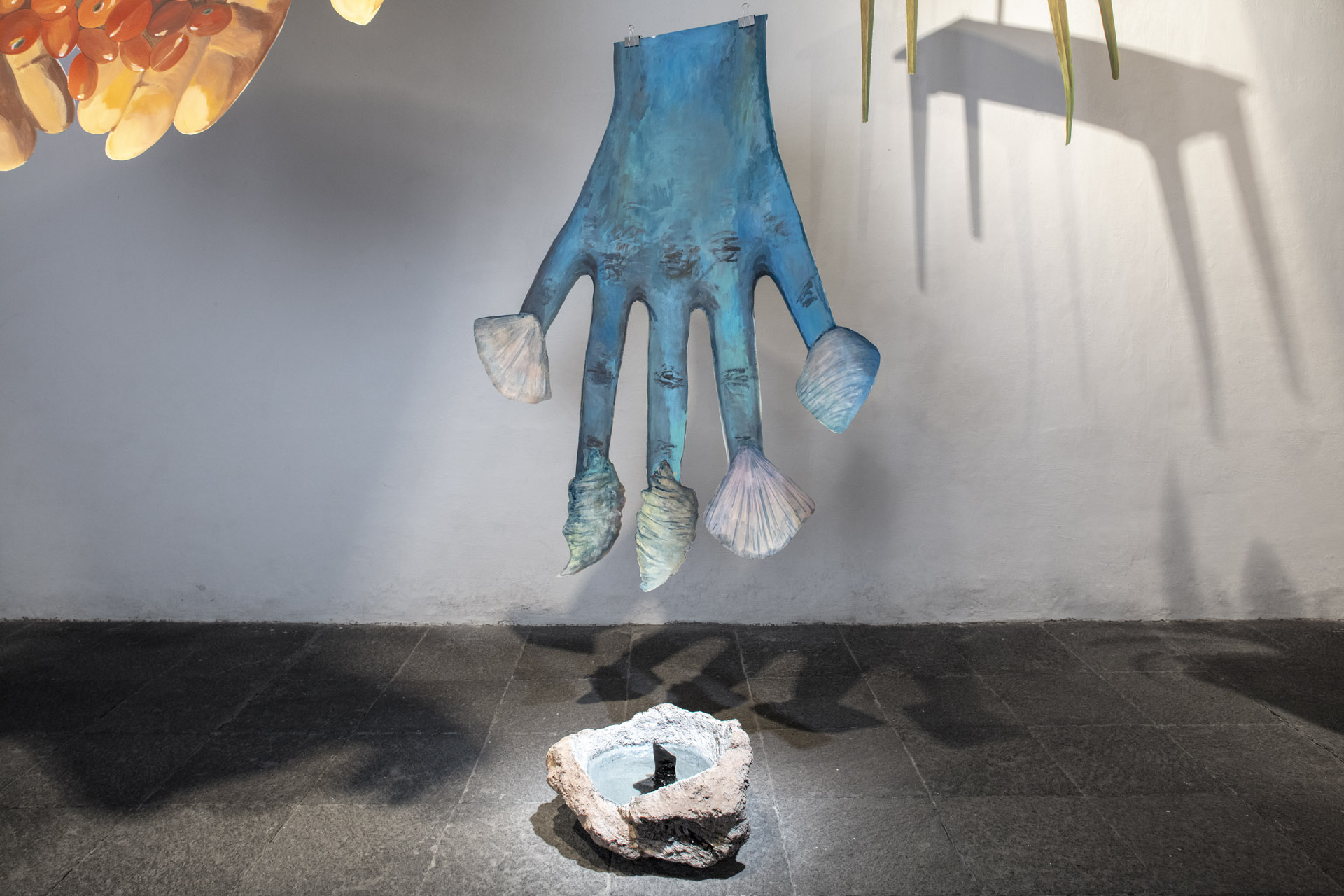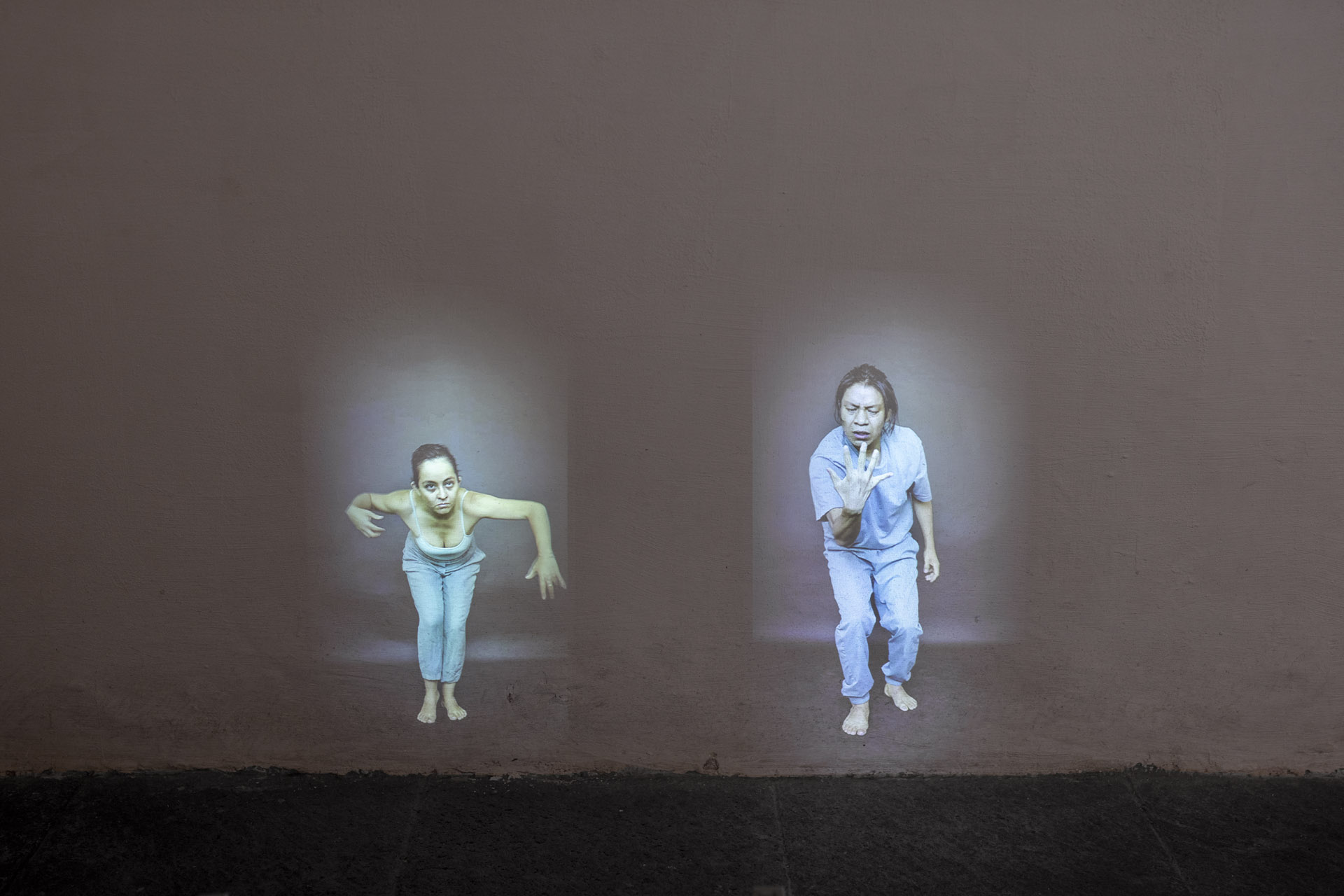Artists: Noé Martínez and María Sosa
Exhibition title: Tepalcates de Sueños
Curated by: Swiss Institute
Venue: Seminario 12, Mexico City, Mexico
Date: May 26 – July 17, 2021
Photography: all images copyright and courtesy of the artists, Swiss Institute and Seminario 12, Mexico City
Tepalcates de Sueños is a collaborative, site-specific exhibition by Noé Martínez and María Sosa that features a two-channel video, a musical composition and a cascade of new paintings depicting animals, plants, bodies and landscapes. This exhibition marks a third chapter in the artists’ evolving engagement with New York-based arts non-profit Swiss Institute (SI), which commenced in 2020 with a virtual residency that later developed into El encuentro de los tepalcates, a performance held on the organization’s roof terrace in May 2021.
The artists’ dreams inform the sounds and images that populate the ground floor gallery of Seminario 12, a 400-year-old residence in Mexico City’s Centro Histórico. Martínez and Sosa, who have lived together since 2010, uphold a longstanding practice of cataloging their dreams and, later, sharing them with one another. The exchange reflects the artists’ commitment to investigating and mapping the continuities between pre-Hispanic and present worlds, cultivating such links as acts of healing and resistance towards colonial hegemony. Giving form to their fragmented dreams is an act of both discovery and maintenance in an attempt to resolve the dissonance between dominant historical narratives and embodied memory. Often set in the natural world and guided by familial and ancestral relations, Martínez and Sosa’s dreams comprise a transgenerational index of their respective Huastec and Purépecha lineage. For the artists, rather than a departure from “waking” time, their dreams mark a vital extension of it in which knowledge is acquired and tradition is lived.
Twenty paintings appear to float through the gallery in a preternatural arrangement. In Nauhatl numerology, the number 20 signifies the human body. As such, the ten paintings contributed by Martínez measure his height of 1.68 meters, while the ten paintings contributed by Sosa measure her height of 1.58 meters. On the back of each painting, text written in black ink details the dream that precipitated the image. Within these diaristic documentations, residues of history accumulate. Hands cupping a cluster of red beans appear in the Borbonicus, Tudela and Florentine Codices and an opossum seen sitting on stone steps (an important symbol in Mesoamerican cosmology) can be found in the Dresden, Vaticanus and Nuttal Codices, amongst others. Trees, also illustrated in such manuscripts, recur: a spindly forest is cast in a blue haze, a twisted trunk is adorned with hand-carved symbols, bark splits open to reveal a crimson cave. Below, carved volcanic rocks spotlit and filled with water form an archipelago that spans the gallery floor. These luminous pools and their reflections evoke the atmosphere of Tlalocan, an Aztec paradise ruled by Tlaloc, god of rains. Beneath these artworks, beneath the feet of visitors and beneath Seminario 12 lie the ruins of El Templo de Tezcatlipoca. A major deity of the Aztec pantheon, Tezcatlipoca is the omnipotent god of the night sky, under which infinite dreams unfold.
Two performances will be staged during the exhibition. The first, newly developed for Tepalcates de Sueños, follows the artists as they improvise movements while recalling the dreams represented in the gallery. A video of Martínez and Sosa’s preparatory exercises for this performance is projected near the entrance of the gallery. The second performance is a reprise of El encuentro de los tepalcates, now held in the artists’ home city. Dressed in handmade garments made from dyed cloth, metal and bone, the artists engage in personal rituals to forge cross-temporal, interspecies connections. Inscribed on their bodies are excerpts from poems, critical theory and ancient texts. Throughout the performance, together, Martínez and Sosa announce themselves in Nahuatl and Purépecha: “Na notokash Noé.” “Ji jakánkurinhasïnk´a María.”
Tepalcates de Sueños is made possible by the generosity of Clarice O. Tavares and the support of Credit Suisse. Swiss Institute wishes to thank Carolina Coppel, César López Negrete, and Aleida Pardo Hernandez of Seminario 12. Noé Martínez and María Sosa wish to thank Emanuel Aguilar, Mauricio Cadena, Carlos Arrollo Eloisa, Julia Fischbach, Sergio Molina, Rodrigo Peñafiel, Alberto Rubí Romero, Clarice O. Tavares, Marina Villalobos and Fernando Yañez.
This exhibition is organized by Daniel Merritt, Curator and Head of Residencies.
Noé Martínez (b. 1986, lives and works in Mexico City, MX) is a visual artist and filmmaker who graduated from Escuela Nacional de Pintura, Escultura y Grabado (“La Esmeralda”), Mexico City. His work functions as a case study that emerges from personal history, making use of ethnographic methodologies and research of the various histories of indigenous communities of the American continent. His work has been presented at the Orange County Museum of Art, Santa Ana (2020); The Museum of Contemporary Art, Chicago (2019); 21 Bienal de Arte contemporáneo SESC Videobrasil, Sao Paulo (2019); FilmFront, Chicago (2019); Native Crossroad Film Festival, Norman (2018); Festival Internacional de Cine, Morelia (2018) Festival Internacional de Cine, Morelia (2018), where he, with María Sosa won the Eye to the Best Short Film of Michoacán Award; and International Performance Art Week, Venice (2016).
María Sosa (b. 1985, lives and works in Mexico City, MX) holds a Bachelor of Arts degree from the Universidad Michoacana de San Nicolas de Hidalgo. Her work develops from research about colonial pasts and how they shape contemporary racial, sexual and social dynamics in the American continent. Throughout her practice, Sosa pays particular attention to the eradication of knowledge surrounding non-western ways of life and prehispanic cultures. Her work has been exhibited at Fundación Casa de México, Madrid (2022); Laboratorio de Arte Alameda, Mexico City (2021-2022); Tale of a Tub, Amsterdam (2021); Arewá, Madrid (2021); Servais Family Collection, Brussels (2020); Lasécu Artothèque, Lille (2019); FilmFront, Chicago (2018- 2019); Native Crossroad Film Festival, Norman (2018); Festival Internacional de Cine, Morelia (2018), where she won the Eye to the Best Short Film of Michoacán Award; and International Performance Art Week, Venice (2016).































